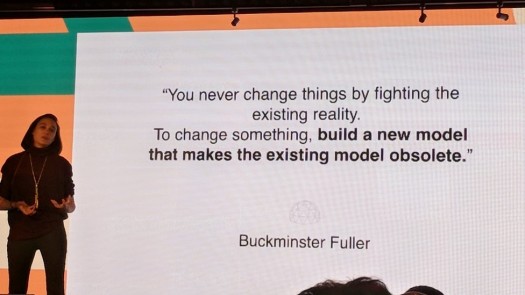
At Monkigras last week there were more women speaking than men. It rocked my world. The ever-inspiring Dr. Lucy Rogers was the only familiar face. Dormain Drewitz, Pia Mancini, Mazz Mosley and Joni Saylor were revelations in the curated line-up. Then there was the unscheduled Linda Peng who seized the opportunity to promote codebuddies. And that’s just the half of it.
My normal status quo these days is to be all-too keenly aware of the gender of tech speakers. Probably because I am constantly being reminded I am a women-in-tech whether I want to be or not. But somehow with a dozen or so women speaking at Monkigras that simply didn’t happen; somehow I forgot to tune into the gender of the speakers at the time.
In hindsight it was a great snapshot of terrific women working in tech, women who are so confident in what they do and comfortable sharing this knowledge with the audience. For one thing Jesslyn Rose is a great speaker and gave us a great visual language for understanding burnout.
https://twitter.com/AnalyticsPanda/status/959084102824718336
I have never done pager-duty in my life but Charity Majors still had me hanging on her every word as she laid out tech leadership as it should be, driving points home in ways no-one could forget in a hurry.
I noticed Majors’ talk also featured major ‘kerb-appeal’ for my daughter: blue & purple hair, unicorn stickers and name-dropping ‘Rainbow Dash‘.
Incidentally, the talk that would probably appeal most to my son would be Catherine Dixon and her magical ability to make you care about the size of the letter ‘O’ and see how that makes lettering come alive and seem balanced.
https://twitter.com/AnalyticsPanda/status/959019041762545664
And while we are picking favourites, mine was definitely Mandy Whaley’s talk which transported me to the life and times of Marie Curie and was neatly tied in with open source & crowdfunding campaigns. It was not lost on me that it took the tragic death of Pierre Curie to propel Marie out of the shadows and onto the mainstage. Fortunately we’ve come a long way since then. I think.
And what I discovered while listening to the talks, not tuned into gender, was that I could focus on something else: the overarching theme was a call for sustainability in tech & other domains. For instance, I learnt that distressed jeans are not so great for the people creating them. I’m not ready to give up on jeans but I’d like to be better about where I get mine from (babysteps to Patagonia maybe?).
In tech itself we need to figure out how to bring people together to build technologies that last and how to take care of ourselves and each other so we can keep doing that. These are issues for everybody: men as much as women. We need to do this together.
And that’s what I experienced happening at Monkigras. Once tech figures out how to deal with gender imbalances, we can truly all move together onto new horizons. Building sustainable worlds and resilient societies.


